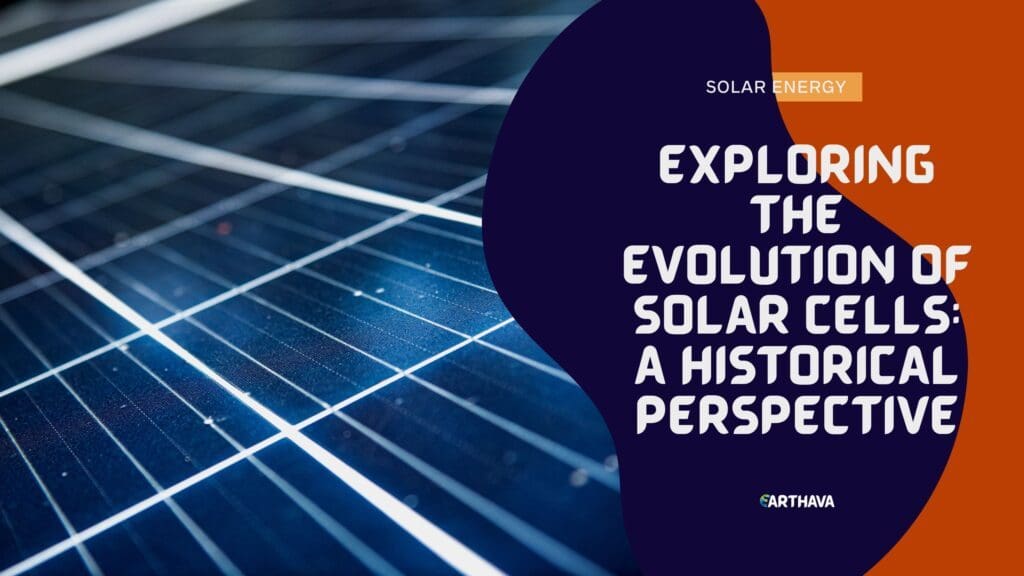Solar Cells have a very long history, starting with some observations carried out by Edmond Becquerel in 1839, Edmond Becquerel is the son of Antoine Cesar Becquerel and the father of Henry Becquerel, both of them were well-known physicists.

Becquerel observed that if two platinum electrodes are placed in solution and exposed to sunlight, electric current flows. His effect was very small and had no practical significance at the time, But it remained unforgotten.
Einstein Efforts
Moreover, This effect wasn’t understood until Einstein delivered an explanation of the photoelectric effect and quantum nature of light in his well-known paper That dates back to 1904, Even this effect remained for a long time one of the most interesting physical phenomena but without any practical meaning.
History Of Silicon Solar Cells
A working solar cell was only realized after semiconductor technology had evolved. In particular, the availability of high-purity crystallized silicon was an important prerequisite, Even today silicon remains by far the most important material for Solar cell production.
The first Silicon solar cell was created in 1954 in the Bell Laboratories in Murray Hill, USA, By the scientists Chapin, Fuller, And Pearson, Even back then solar cells were able to achieve an efficiency of 6 %, Which was soon increased. to 10%. At that time the most important application of solar cells was in space.
This Began In 1958 when the first 108 solar cells were used for the Vanguard satellite. They exceeded all exceptions and supplied the Satellite with energy for much longer than initially expected.
This allowed a limited yet high-quality market for Solar cells to develop. Even the soviet union was level-pegging in the use of solar cells, but due to their secrecy, this was only known later.
Due to high costs, The terrestrial application of Photovoltaics was for a long time rejected as illusionary, Nevertheless, their benefits fascinated scientists and the public so the research never completely ceased.
Step By step solar cells found their way into grid-independent power Supplies. the application began with calculators and watches and gradually evolved to larger machines and other equipment such as parking ticket vending machines. Although silicon isn’t an ideal material for solar cells due to its relatively low absorption of light, it dominated the solar market from early on. One important reason for this was the progress in semiconductor technology.
For many years the solar cell industry lived quite comfortably on the waste products of Silicon production: Silicon Crystals, which didn’t meet the standards for the chip industry were still very useful for Solar cells.
In recent years, however, this symbiosis has become a threat to the market growth of photovoltaics, because the Silicon consumption has increased strength and can only be met by specifically manufactured solar silicon.
The manufacturers of high-purity silicon have responded to this by increasing the production of solar silicon. this is So-called solar-grade silicon has a purity of 99.999% in contrast to the electronic-grade silicon with a purity of 99.99999%. The latter silicon is needed for chip production in the semiconductors industry.
Silicon wafers can either be made from Czochralski single crystals from multi crystals that are poured into blocks. Some methods allow silicon wafers of strips to be drawn directly from the melt.
Other Materials That Replaced Crystalline Silicon
For many decades there were a lot of efforts to replace silicon with other materials. Materials with high light absorption are sought, to make the cells thinner and Thus to save costs. the results are in-film cells which are thinner than crystalline silicon.
The second most important material after crystalline silicon is silicon, namely amorphous silicon. This material is so different from crystalline Silicon that it can be considered as another material.
The first solar cell made from amorphous silicon was produced by D. Carlson as early as 1976. However, the high expectations for this material weren’t met. The efficiencies of amorphous silicon remained significantly lower than those of crystalline silicon and were restricted by temporal degradation.
Today amorphous silicon is an important component in consumer products, In just special applications such as facades and increasingly also in standard equipment, However, The Market Share is still negligible.
A further Thin-film material, which is still at the beginning of its broad market introduction, is CIS (copper indium diselenide), The first CIS in-film solar cell was introduced in 1976 by L. Kazmierski. These cells exhibit stability and reach, at least in the laboratory, high levels of efficiency.
In Germany, the IPE (Institute Fur Photovolaik ) at the University of Stuttgart has contributed to the significant development of this material.
Solar Cells Efficiency
The maximum efficiency of crystalline silicon ( a cell ) that is achievable in theory lies at approximately 31%. Higher efficiencies can be achieved by combining different materials in so-called tandem cells or by using concentrating cells.
Today a Large-scale production of Solar power from photovoltaics deploys almost exclusively monocrystalline or polycrystalline silicon cells. Here, Module efficiencies of 14 – 20 % can be reached. probably, module efficiencies will Soon exceed 20 % for monocrystalline silicon cells.
Source
Planning and Installing Photovoltaic Systems: A Guide for Installers, Architects, and Engineers (Hardcover)
By (author): Deutsche Gesellschaft für Sonnenenergie (DGS)
